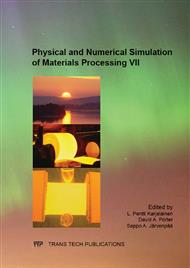p.152
p.158
p.165
p.171
p.176
p.183
p.189
p.194
p.210
Microstructural Evolution during Tempering of 16Cr-5Ni Stainless Steel: Effects on Final Mechanical Properties
Abstract:
In this work, the structural behaviour during tempering of two different heats of 16Cr-5Ni supermartensitic stainless steel has been studied by means of dilatometry, transmission electron microscopy and X-ray diffraction. A thermomechanical simulator (Gleeble 3800) has been also used to characterize the effects on final mechanical properties of different tempering temperatures in the range 600 °C to 700 °C and the influence of sub-zero cooling on industrial double tempering treatments. It has been found that the pre-existence of retained austenite in as-quenched conditions can induce significant differences in the microstructural evolution during tempering and on the final mechanical properties of industrial components, thus inducing problems in controlling final maximum hardness allowable by normative requirements.
Info:
Periodical:
Pages:
176-182
Citation:
Online since:
July 2013
Price:
Сopyright:
© 2013 Trans Tech Publications Ltd. All Rights Reserved
Share:
Citation:


